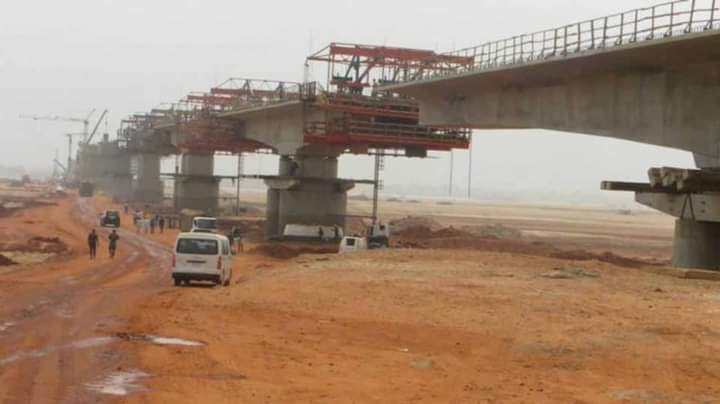By Tony Oneweek Muonagor
Love him or hate him, Muhammadu Buhari will secure his place in history (and in the hearts of South Easterners) as the man who delivered the second River Niger Bridge. The Federal Goverment has told us that the bridge will become operational this year 2022 and our prayer is that it becomes a reality. December after December, my people suffer untold inconvenience crossing from Asaba into their Villages to celebrate Christmas. Imagine the free flow of traffic when we start using the Second Niger bridge. It will certainly be a much needed breath of fresh air as the unbearably tormenting gridlock on the present River Niger bridge becomes a thing of the past. We could even make the entire incoming vehicles use one bridge while all outbound ones use the other.
Imagine the overall boost in businesses hitherto suppressed under the harsh challenges of the gridlocks of the first Niger bridge. No more endless queues during festive periods. Did you know that most Onitsha traders live in Asaba and this has activated a major traffic scare occasioned by the daily surge into Onitsha in the morning and out of Onitsha in the evening. These days, you would count yourself lucky any time you do not meet a gridlock at the head Bridge. Imagine the joy that the new Niger Bridge will bring to the Commuters. It will surely inject a new life into the Socio-Economic potentials of Anambra State and indeed the South East and South South.
Now, come with me and perhaps you would learn a bit of history. Was it not the legendary Bob Marley who sang: “If you know your history, then you would know where you are coming from…, then you wouldn’t have to ask me: Who the heck do you think I am…”. These were the lyrics of Marley’s hit song titled “Buffalo Soldier”. History is no doubt a subject that is inevitable in the life of every man, nation or people. No wonder the Igbo saying “Onye amaghi ebe mmili siri bido maba ya, agaghi ama ebe o ga akwusi” has remain popular. Simply translated, it says “He who doesn’t know where the rain started beating him may never know where it will stop”.
The source of our River Niger is the Guinea Highlands, South east of Guinea near the Sierra Leone boarder. Yes. That’s from where the waters we see in Onitsha came from. It runs in a crescent through Mali, Niger, on the boarder with Benin and then through Nigeria, discharging through a massive delta, known as the Niger Delta or the Oil Rivers, into the Gulf of Guinea in the Atlantic Ocean. With a length of 2,600 miles (4,200 km), the River Niger is the third longest river in Africa (after the Nile and the Congo) and is used for irrigation, power production and transportation. The Niger River and its Inner Delta are vital for agriculture, livestock, fisheries, transport, energy, tourism, and water filtration, as well as a habitat for a range of fish and other aquatic animals, including a variety of protected species.
The Niger River is often referred to as the pulse of West Africa. Communities living within the basin are heavily reliant on the environmental products and services provided by the river and its surrounding area for their livelihoods. The River Niger was and still is a major source of livelihood for many riverine communities of Anambra State, Delta State and Rivers State.
Have you ever imagined Life without a bridge across the River Niger. Sounds impossible but this was simply the norm for centuries until the year 1965 when the first bridge was built. Oh yes. The Asaba-Onitsha ferry transport was used to transport people across the River Niger. This was prior to the construction of the famous Onitsha Bridge.
It was a Scottish explorer named Mungo Park who traveled overland from the Gambia region and reached the Niger near Ségou, where in July 1796 he established that the river flowed eastward. So the River Niger was discovered towards the end of the 18th century but the very first bridge across the River Niger connecting the rest of the world to the South East and South South was built in the 20th century.
The present River Niger bridge, linking Onitsha and Asaba was completed in December 1965. It was built by the French construction giant, Dumez. It’s total length is 4,606 feet (1,404m) and the entire construction took about a year (1964 to 1965) to complete at the cost of £6.75 million. It is as noteworthy as it is commendable that the existing River Niger Bridge was built by Alhaji, The Right Honourable Sir Abubakar Tafawa Balewa KBE who was Prime Minister of Nigeria from August 30, 1957 to January 15, 1966 when he was assassinated in a bloody coup. In fact the commissioning of the River Niger Bridge on January 4, 1966 was his last assignment outside Lagos as Prime Minister. He was killed eleven days later near Lagos. May his soul rest in peace.
During the Nigerian Civil War of 1967 – 1970, the retreating Biafran soldiers dynamited the Niger bridge. The destruction of the bridge was done to halt the advancement of the Nigerian military into Onitsha. The move left the Nigerian army frustrated at the Asaba side of the river.
Immediately after the war, courtesy of the then West Germany who had provided a grant of £116,000 towards the reconstruction, the Niger bridge was re-opened on Thursday the March 26, 1970. In other words the Bridge that we all use today to cross the River Niger was built in 1965, destroyed in 1967 and repaired in 1970.
According to Wikipedia, The Second Niger bridge is a Nigerian Federal Government project that is 1.6 km long and furnished with other ancillary infrastructure including a 10.3 km highway, Owerri interchange and a toll station all at Obosi city, expected to be completed in the year 2022. It has a total length of 1,630m and will cost: ₦336 Billion. It’s Construction started September 1, 2018 and is projected to be opened to the public by February 2022. Did they say February 2022? We are in 2022 and this is February. I believe it’s better to say 2022 and leave out the month. The bridge was initiated under the administration of Goodluck Jonathan and is being sustained by President Muhammadu Buhari. It is now at 80 percent completion. It was initially being built by Public Private Partnership (PPP), but now it is being built from the Sovereign Wealth Fund as one of the five legacy projects that President Buhari will leave for the country. God bless him.
The war is over. Let my people pass.
Muonagor wrote from Awka.


